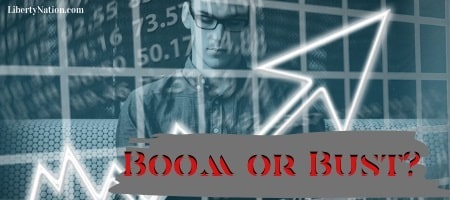The year is 2029. The world has lost the war on Coronavirus, as half the planet refused to wash hands and practice basic hygiene. Millions are in quarantine, global commerce has come to a screeching halt, and societies are in ruin. And yet, in the deepest recesses of the Eccles Building, where the smell of sulfur and ink are prevalent, the printing press is operating 24/7 to keep the Dow Jones Industrial Average and the S&P 500 trading at all-time highs. The Federal Reserve spoke into an empty telephone and assured financial markets that it could keep growing the bubble, sustain record-high 401(k) accounts, and bail out repo markets. The world has been obliterated, but the U.S. central bank still stands.
Fed Plays the Interest Rate Card
For the first time since the financial crisis in 2008, the Federal Reserve announced an emergency cut to interest rates. The central bank reduced the benchmark fed funds rate by 50 basis points to a target range of 1% to 1.25% as part of the institution’s efforts to help stabilize equities and ensure the national economy can combat the fallout from Covid-19.
The Fed’s easing took markets by surprise, especially with officials discouraging investors from pricing in a rate cut. The central bank confirmed in a statement that experts had sounded the alarm about the outbreak’s “evolving risks” to the country, so it could no longer sit on its hands on the sidelines.
Fed Chair Jerome Powell told reporters:
“The magnitude and persistence of the overall effect on the U.S. economy remain highly uncertain, and the situation remains a fluid one. Against this background, the committee judged that the risks to the U.S. outlook have changed materially. In response, we have eased the stance of monetary policy to provide some more support to the economy.”
With the March Federal Open Market Committee (FOMC) meeting only two weeks away, some analysts are anticipating an additional interest rate cut. Should Coronavirus fail to be contained by the summer, there is a good chance rates could fall to zero by the end of the year. This would please President Donald Trump, who simultaneously commended the Fed’s decision and criticized the century-old institution for not doing more.
“The Federal Reserve is cutting but must further ease and, most importantly, come into line with other countries/competitors. We are not playing on a level field. Not fair to USA. It is finally time for the Federal Reserve to LEAD. More easing and cutting!” he tweeted.
Treasury Secretary Steven Mnuchin, who was coy about the G7’s tools to go toe to toe with the virus, celebrated the cut.
Apocalypse Wow!
Were the markets happy, at least? Well, they did receive a temporary boost after the initial announcement, but then they cratered as fast as you can say cat in a hat. The Dow Jones plummeted 785 points, the S&P 500 fell 2.8%, and the Nasdaq plunged 286 points. Although Wall Street had been begging for a rate cut, the decline could likely be attributed to the central bank conceding that the virus outbreak is worse than many had initially thought. Equities have rebounded since.
 Now that the Fed is leading the charge, other central banks are following suit. Australia, Hong Kong, Canada, and Malaysia cut interest rates, and Japan recently announced that it was adding tens of billions of dollars’ worth of liquidity to cushion stocks. For the rest of March, England, India, New Zealand, and Mexico are widely expected to accommodate and give investors some breathing room. China is also forecast to add to its two-dozen monetary tools after cutting rates and injecting stocks with liquidity.
Now that the Fed is leading the charge, other central banks are following suit. Australia, Hong Kong, Canada, and Malaysia cut interest rates, and Japan recently announced that it was adding tens of billions of dollars’ worth of liquidity to cushion stocks. For the rest of March, England, India, New Zealand, and Mexico are widely expected to accommodate and give investors some breathing room. China is also forecast to add to its two-dozen monetary tools after cutting rates and injecting stocks with liquidity.
An adjustment to rates typically takes about three to five months, so markets will only witness the benefit of easing by the spring, though they may push higher based on expectations and sentiment. Unless the Fed can develop a magical vaccine to eradicate Covid-19, rate cuts may not be enough to calm investors, spur growth, and ensure the bull run is sustained. Because there is still so much uncertainty surrounding Coronavirus, the global economy may not be able to recover for a year, as so much progress has been lost and destroyed.
The End is Near
Is the end near? You cannot help but wonder if the U.S. economy is in the late stages of the boom phase of the business cycle. Before the Coronavirus outbreak, all the data pointed to sustainable growth for the rest of 2020: an expanding balance sheet, modest rates, and trade certainty. Whether expansion is still achievable or not is a moot point after the monetary policy maneuver. The real question now is: What will the Fed do when the recession strikes? If the Powell Putsch was running out of steam a few months ago due to the repo market madness, then the effort will be out of momentum. There will be nothing the Fed can do in the next economic collapse unless it wishes to destroy the greenback. It may be time to stockpile your gold, N-95 masks, and Mr. Noodles packages.
~
Read more from Andrew Moran.



